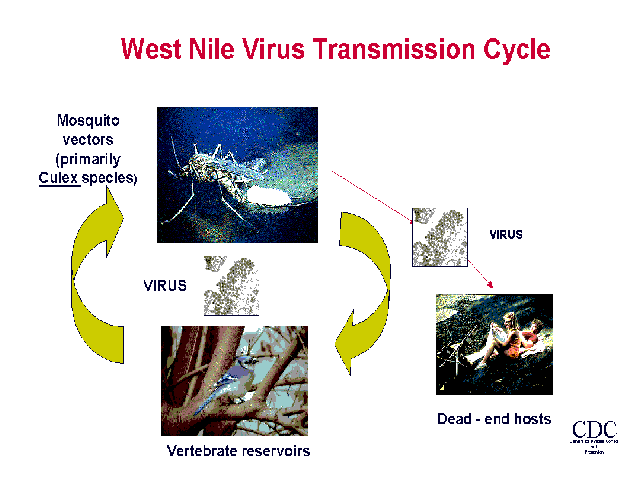
Home | Yellow Fever | Dengue | Japanese encephalitis | Hepatitis C | West Nile Virus
In August of 1999, an outbreak of encephalitis accompanied by severe weakness and axonal neuropathy occurred in Queens, New York. After initial analysis, the serological presence of antibodies of infected patients lead researchers to believe that the virus responsible for the outbreak of encephalitis was St. Louis encephalitis virus, a member of the virus family flaviviridae. However, the genetic analysis of the virus isolated from infected individuals revealed that it was not St. Louis encephalitis but another flavivirus, West Nile virus. This launched a bigger question. How did the West Nile virus come to New York? There are three different ways the West Nile virus came to the United States: In a person infected with West Nile virus; in a mosquito infected with the virus; or in a bird infected with the virus. There was high avian mortality in New York that summer. In total, there was confirmed infection in 59 human beings, 103 birds, and 12 horses. The West Nile virus is an arthropod-borne virus, which is spread by mosquitoes in the genus Aedes. The question of how West Nile virus came to the US remains unanswered but many believe that the virus came in migrating birds. A mosquito (probably Aedes vexans) may then have bitten the bird, became a vector, and spread it to other animals, including humans. After the outbreak, a major effort was launched in an attempt to reduce the mosquito population.
There are two subtypes of West Nile virus that can be distinguished by antigenic variations in their envelope protein and the presence of an N-glycosylation site at amino acids 154-156. The first lineage which includes Kunjin virus and West Nile viruses are found in Europe, the Middle East, North Africa, Central Africa, and West Africa. The second lineage comes from West Africa, Central Africa, East Africa, and Madagascar. It is believed that the virus that caused the outbreak in New York is from the Middle East and caused outbreaks of encephalitis in Israel and Egypt. The virus found in New York was 99.8% similar to the West Nile virus that caused encephalitis in Israel in 1998. West Nile virus is considered to be very similar to Japanese encephalitis virus. Outbreaks of West Nile virus during 1996 had mortality rates as high as 8% in Romania. West Nile virus has proven to be a dangerous emerging virus which causes encephalitis and possibly death.
References